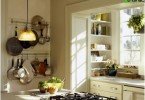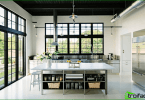Which tile is better to choose
None of the most modern finishing materials in the design of kitchens and bathrooms have yet succeeded in surpassing traditional tile in popularity. Moreover, designers are willing to use this practical material in the interiors of living rooms and bedrooms, and the modern incarnation of old tiles – porcelain tiles adorn public spaces, offices and facade walls of houses. The range of building decorative ceramics on the market is huge and a few tips on how to choose a tile for facing a kitchen or bathroom will help you navigate among many collections from inexpensive domestic tiles to exquisite ceramics from famous Western brands that differ not only in design but also in operational characteristics.
Content
- 10 reasons for the popularity of tiles
- We study the marking on the package
- Wear resistance is not a synonym for quality
- Tile Design Secrets
10 reasons for the popularity of tiles
The tile is unrivaled, not only because of the beautiful exterior design. Indeed, along with wood and natural stone, she is a representative of a not-too-long list of “healthy” materials that a person safely uses in his home.
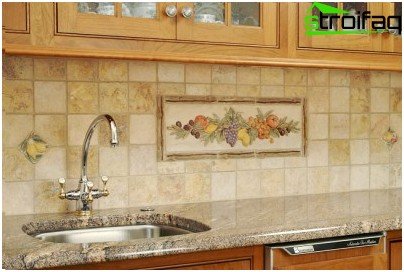
The artificially created tile combines three natural elements – clay, water and fire, and this already inspires confidence
The artificially created tile combines three natural elements – clay, water and fire, and this already inspires confidence, which in the eyes of the consumer multiplies the list of advantages of ceramic tiles:
- environmental friendliness: does not emit harmful fumes, fully complies with international environmental standards;
- hygiene: easy to clean, does not react to aggressive environments of detergents;
- high strength subject to the rules of installation;
- high moisture resistance and water resistance;
- refractory properties and heat resistance;
- fire safety: it does not burn and does not support combustion;
- good thermal conductivity: ideal as a floor covering for any “warm floor” system;
- antistatic – “immunity” from electromagnetic fields, due to the almost absence of electrical conductivity;
- a wide range of colors and textures, compatibility in the interior with glass, metal, wood, plastic;
- affordable price.
The problematic characteristics of the tile include fragility during transportation and a very large weight, and the high thermal conductivity that was always considered a disadvantage with the invention of the heating system “warm floor” turned into one of the advantages of building ceramics.
We study the marking on the package
With a huge assortment of universal ceramic tiles, the market cannot offer and, deciding which tile to choose for the bathroom or kitchen, in addition to the external design, one should take into account how the operational properties of the sample you like correspond to its intended purpose.
You can get the most information by carefully studying the marking in the form of pictograms on the tile packaging.
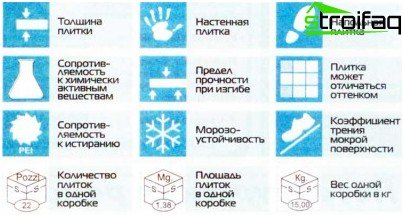
Tile marking contains a maximum of useful information about its purpose and performance
The image of the foot on a black background of the pictogram says that the tile is designed for laying on the floor, and if the foot is depicted on a shaded background – in front of you is a tile of increased wear resistance. The image on the markings of the hand means that the tile is suitable only for wall cladding. The snowflake in the pictogram indicates frost resistance of the material. If the same icon is repeated twice or thrice on the icon, this indicates a high level of the corresponding indicator.
Both the kitchen and the bathroom need ceramic tiles with low porosity, which can withstand the effects of moisture and aggressive chemical compounds – fats, acids, alkalis. For this indicator, letter marking is provided on the package and it will help to determine with a high degree of accuracy which tile to choose for the floor and walls of the kitchen or bathroom.
- A – tiles with high resistance to water, chemicals and mechanical stress.
- B and C – tiles with an average degree of resistance to moisture and chemicals.
- D – decorative ceramics not resistant to moisture and chemicals.
In the bathroom or in the home pool, both the floor and the walls are constantly in contact with a large amount of water, steam, detergents, as well as with reagents for disinfecting water, which can stain and destroy the glaze of ceramics. In the kitchen, humidity is lower, but it is more likely that not only chemically aggressive detergents, but also fats or acids contained in food products, get on the tile. Therefore, for one and for another room, you should choose a facing tile labeled AA or, in extreme cases, A.
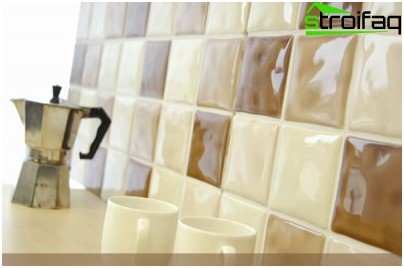
For the bathroom and the walls of the kitchen there is no need to buy a tile with a high degree of wear resistance, more important is its resistance to moisture and aggressive environments
The wear resistance of the tiles on the marking is indicated by Roman numerals I-V and according to this indicator, the requirements for tiles for the kitchen and bath are different. For the bathroom and the walls of the kitchen there is no need to buy tiles with a high degree of wear resistance, more important is its resistance to moisture and aggressive environments. But for the kitchen floor you will need a strong, low-porosity, chemically resistant tile, usually III class wear resistance.
Wear resistance is not a synonym for quality
Wear resistance or abrasion resistance is the most important technical characteristic of tiles, determining its scope.

Wear resistance or abrasion resistance is the most important technical characteristic of tiles, determining its scope
According to the norms of domestic and foreign standards, ceramic tiles, depending on the purpose of the room traffic density in it, is divided into five wear resistance classes, indicated by the abbreviation REI and the corresponding Roman numeral:
- REI I – floor tiles of the first class for rooms with low traffic density, it is quite suitable for bathrooms;
- REI II – a tile of the second class is designed for places with low traffic intensity and is suitable for residential premises, except corridors, kitchens, loggias and balconies;
- REI III – tiles of the third class can be used in the decoration of residential premises with an average degree of traffic intensity that do not have direct access to the street: kitchens, halls, covered terraces and loggias;
- REI IV – a tile of the fourth class is designed for floors and walls of offices, clinics, hotels and other public premises, as well as corridors and hallways in apartments and residential buildings;
- REI V – tiles of the fifth wear resistance class are suitable for rooms with any degree of traffic intensity, from shopping and office centers to production shops, car dealerships, warehouses.
In residential premises, with the exception of the hallway, it is recommended to use tiles no higher than class III wear resistance for decoration. The fact is that the term “wear resistance class” means only one technical characteristic of the product, but not a quality indicator or grade. Suppose before you in the assortment of tiles for the bathroom: which one to choose, to serve for a long time and cost inexpensive?
The abbreviation AA on the marking icon and the wear resistance class I-II are ideal for you. After all, laying IV-V tiles of wear resistance or resistant to low temperatures on the bathroom floor, you will overpay for product specifications that will never be in demand in a living room.
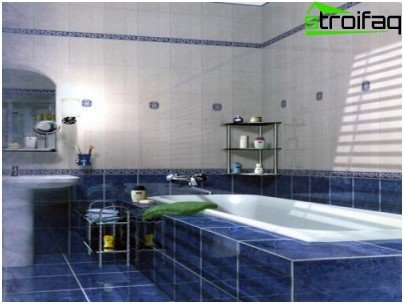
Tiles with high resistance to moisture and chemicals are ideal for the bathroom, and I-II wear class is acceptable
Ceramic tiles of domestic manufacturers come in three grades and there are differences in quality and price between them. The variety is not indicated on the products of foreign manufacturers: it is understood that only a high-quality product can fall into the hands of the consumer. At the same time, international standards require labeling of packaging of the highest quality tiles with red inscriptions, tiles of the second grade should be marked with blue marking, and the third grade should be marked with green.
Tile Design Secrets
Having understood the main technical characteristics of the tile, do not forget to check for foreign inclusions, bubbles, grains of sand, bulges, concavities, cracks and chips on the surface of the products. It is very important for the bathroom and kitchen floor that the coating is not slippery.
Important: Matte tiles have a higher coefficient of friction on a wet surface or slip resistance than glossy. Satin-tiled tiles are suitable for fans of brilliant finishing materials – brilliant, but not slippery, thanks to the addition of special salts to the glaze.
An ill-conceived choice of tile color or an unsuccessful choice of its texture can lead to unpredictable annoying effects. To make a small bathroom or kitchen seem more spacious, in their decoration should use lining materials of light pastel colors..
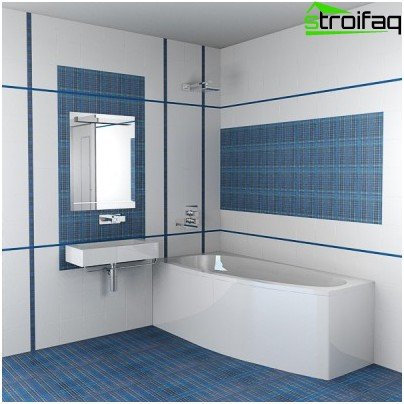
When you design a small bathroom, you should choose light, calm tones and do not use more than three colors of tile
In the interior of a small room it is not recommended to use more than three shades of ceramic tiles – this technique also reduces the volume.
Important: Tile with a glossy shine visually reduces the volume of the room. If necessary, choose a tile with a low reflection coefficient, that is, with a “matte” glaze.
Contamination, spots and limescale are less noticeable on tiles with a granular or chromatic surface texture. On the glossy surfaces of cladding ceramics of dark and black colors, even slight chips and scratches are too noticeable. Choosing the color and texture of the tiles in the kitchen or bathroom, do not forget about practicality.
A competent choice of the necessary technical characteristics of the tile, as well as a carefully thought-out color scheme will help you, without making mistakes and saving money, to get a beautiful and durable tile for the bathroom or kitchen.


